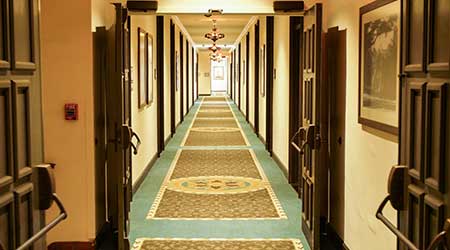« Back to Facilities Management Design & Construction Category Home
5 Keys to Success in Historic Building Preservation

Herrmann Hall, a historic lodging facility at the Naval Postgraduate School in Monterey, Calif., recently received an $18 million renovation. (Photo: DeNoise Productions)
June 13, 2018
- Design & Construction
By Joe Mark
Renovating a historic building is unlike any other construction project. It comes with unique challenges and issues that facility managers must consider before any demolition or retrofitting begins.
A recently completed an $18 million renovation of Herrmann Hall, a historic lodging facility at the Naval Postgraduate School in Monterey, Calif., offers lessons that can be applied by any owner looking to invest in or restore an old building. The building opened in 1880 as the Hotel Del Monte, one of America’s top luxury hotels, before being leased to the U.S. Navy during World War II.
Here are five things you should keep in mind when renovating a historic building:
1. Negotiate Unforeseen Fees
Facility managers cannot rush the design phase when it comes to renovating a historic building. The in-house design team should understand the ins and outs of the building and be fluent in the design plan at the start of the project. That means investing time at the front end to perform laser scanning and other planning before demolition begins.
By adequately planning in advance, facility managers can avoid being nickel-and-dimed for unexpected billable work down the road. For example, a historic building could have a surprise support beam in the ceiling or wiring in places facility managers did not anticipate, so the design team must be flexible. Negotiate the way unforeseen work and fees will be handled if and when they arise.
2. Confirm Permitting and Restrictions
Involve the necessary local authorities and historical preservation boards before starting the project to ensure the renovation complies with any regulations or standards. Facility managers can save themselves time, money, and headaches down the road by doing this research well in advance.
By solidifying plans with various stakeholders, including the fire marshal and code enforcement department, facility managers can mitigate risk and avoid the costs of having to undo and rebuild certain elements after the fact.
3. Consider Design Elements
Facility managers do not have to wait until they have a general contractor on board to start making a wish list of design elements to include in the renovation. Do not come to the table empty handed. Do a walkthrough and determine the elements to preserve in the design. Think about specific colors to include throughout. Collect example images that are similar to desired design elements.
Being prepared and providing these ideas to the general contractor can speed up the renovation process.
4. Establish a Contingency Fund
It is crucial to establish a contingency fund when diving into the renovation of a historic site. Set aside about 2.5 percent of the total budget to cover any unforeseen expenses. Again, there tend to be more surprises when it comes to older buildings.
Facility managers do not necessarily need to share this contingency fund with the general contractor. Think of it as a security net. It provides flexibility for any desired changes during the process or for any renovations that do not go as planned.
If you do not have 2.5 percent in cash to set aside, the next best thing is to create a value engineering list — a list of things to forgo if unforeseen problems eat into the budget. Not having a list like this can create major delays when things do not go according to plan.
5. Involve the Maintenance Team in the Process
The maintenance team is responsible for the day-to-day upkeep beyond the renovation phase, so it is important that they are a part of the process. Building owners and maintenance managers should meet before developing a request for proposal (RFP) or meeting with a general contractor. Among the issues to discuss with the maintenance team:
• Do they know what infrastructure they want incorporated into the building?
• Are they sizing the current equipment the general contractor is installing for their big-picture plan?
• Should the renovation project costs include equipment replacements?
• Does the fire alarm system need to be replaced? If so, will that be included in the budget for this renovation?
• Does the maintenance team prefer or dislike certain equipment brands? If so, this information should be included in the RFP.
Renovating a historic building is a big undertaking, but it can be a relatively smooth process if facility managers take steps like these to be prepared.
Joe Mark is the operations manager for commercial and military projects at Stellar, a fully integrated design, engineering, construction and mechanical services firm in Jacksonville, Fla. Stellar recently completed the $18 million renovation of Herrmann Hall, a historic lodging facility at the Naval Postgraduate School in Monterey, Calif.








